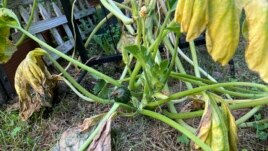21 August 2023
Water is required for plant life. But what happens when there is too much of a good thing?
That has been the case in many parts of the world this summer. Scientists say extreme rainfall happens more often now as storms form in an atmosphere made warmer by climate change.
Nick Goltz is head of the UConn Plant Diagnostic Laboratory at the University of Connecticut in Storrs, Connecticut. He said too much water can mean dead plants in a garden.

This July 31, 2023, image provided by Jessica Damiano shows a squash plant with yellow, wilted foliage — symptoms that present after both flood and drought — on Long Island in New York. (Jessica Damiano via AP)
Goltz explained that flooding cuts off the oxygen supply which leads to root-rot diseases. And then plants cannot pull enough water to survive. The result is yellow, weakening leaves, which would usually show a plant's need for water. But after flooding, those same signs mean that roots under water cannot function in really wet conditions.
What you can do
Avoid walking on wet soil if your garden has been affected by flooding. Wait until the soil has mostly dried before looking at the damage. Adding any weight or pressure to wet soil can cause even more oxygen to be pressed out from around struggling roots.
A plant with just a few signs of damage may recover, but a plant that is completely weakened probably will not, Goltz said. He added that plants with strong, deep roots – like trees and yearly returning plants – have the best chances of recovery.
Annuals are plants that live for less than a year. Their roots are not as deep and they are at risk if flooded. Goltz advised removing annuals if they look unhealthy.
Plants weakened or stressed by flood water can more easily get diseases and unwanted insects. So keep an eye on them and treat problems as they come, which could be months later.
Broken tree branches should be removed immediately. But save any major removal of leaves and branches for when conditions improve to avoid further weakening an already stressed tree.
Are fruits and vegetables safe to eat?
Flooded fruits, vegetables, and other crops should be considered unsafe and not eaten.
Goltz said, "If the part you're eating touches the water, then it's unsafe," even if washed or cooked. That is because in addition to bacteria from standing water, runoff from nearby gardens, chemicals, and other waste could be present, Goltz added.
However, if your garden was flooded but the food part of the plant was not, "then it can be eaten," Goltz said. But even then, he said, it is best to wash and cook the food part.
Repairing the soil
After dealing with your plants' needs, turn your attention to the flooded soil, which will also need some care. Flooded soil loses nutrients and can damage the way water flows through it. Mixing in compost will help on both counts and mixing in sand will improve the way water flows through it as well.
If you live in an area that easily floods, there are steps you can take to avoid or lessen future damage, such as growing vegetables in higher areas or raised beds. Or you could direct water away from the plants you care about most.
I'm Gregory Stachel.
Jessica Damiano reported this story for The Associated Press. Gregory Stachel adapted it for VOA Learning English.
________________________________________________
Words in This Story
garden – n. an area of ground where plants (such as flowers or vegetables) are grown
rot – v. to slowly decay or cause (something) to decay
function – v. to work or operate
compost – n. a decayed mixture of plants (such as leaves and grass) that is used to improve the soil in a garden